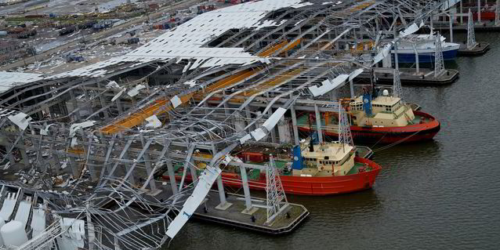Days after Hurricane Ida slammed into the US Gulf Coast as one of its most powerful storms in 150 years, severe disruption to offshore platforms and rigs continued as the US oil and gas industry assessed damage to onshore refineries.
While the offshore sector had worked hard to try to avoid or cope with some of the most extreme storms, most offshore oil and gas production remained shut in. The damage wreaked by Hurricane Ida was shocking — particularly due to impacts on the electricity system.
As of Wednesday afternoon, 80% of Gulf of Mexico oil production, or approximately 1.5 million barrels per day, remained offline, and more than 83% of natural gas output, or 1.9 billion cubic feet per day, was shut in, according to the US Bureau of Safety & Environmental Enforcement.
That represented about 17% of total US oil production and 5% of domestic natural gas output disrupted by the storm as of Wednesday morning on the Gulf Coast.
“As was the case with major hurricane and storm events during the 2016-2020 period, we estimate the cumulative production outage impact to be equivalent to five and a half days of maximum capacity, assuming rapid reactivation to start as soon as 31 August,” Rystad Energy said on Tuesday.
Widespread power outages and damage to the electricity grid hobbled efforts to restore the region’s refineries to business as usual.
About 2.2 million barrels per day of refining capacity remained offline this week and reports soon showed that this was due as much to the “catastrophic” destruction of electricity provider Entergy’s grid as from direct hurricane damage.
About 45% of the nation’s refining capacity is in the US Gulf Coast region.
Port Fourchon took a direct hit from Ida as it made landfall on Sunday as an extremely dangerous Category 4 storm, with winds of 150 miles per hour (241 kilometres per hour).
The port, which serves as a major supply and logistics hub for offshore oil and gas production, is also a departure point for many offshore rig workers.
The Greater Lafourche Port Commission on Monday said that waterways flowing to and within Port Fourchon were blocked by multiple obstructions and sunken vessels, and access roads were closed.
“Vessels should not attempt to enter or exit the port until the port commission’s damage assessment has been completed and the all clear is given,” the commission said.
Port Commission executive chairman Chett Chiasson said in an interview with National Public Radio that the damage to Port Fourchon was “extensive” and “far-reaching”.
“It’ll take weeks to get things back up and running. How many weeks is a good question,” he said.
Chiasson said Port Fourchon is without electricity or running water and, with access to offshore rigs cut off, he predicted that oil and gasoline prices would likely increase.
Crude markets took a more sanguine view, with West Texas Intermediate crude prices remaining stable this week and dropping more than 1% on Wednesday.
Production remains shut in
With impacts on logistics, hopes of a speedy recovery for production were in limbo although offshore damage seemed to be relatively limited, even in the storm’s pathway.
Anglo-Dutch supermajor Shell said that its Mars, Olympus and Ursa platforms were intact and on location despite being in the direct path of the storm. Some of the flyover inspections were still being assessed.
The company said its floating production, storage and offloading vessel Turritella had resumed production, while its Perdido asset in the south-western US Gulf remained online throughout the storm.
“All other assets remain shut in and fully evacuated at this time,” Shell said.
In its daily update, US supermajor Chevron said its US Gulf platforms remained shut in, as did its Fourchon and Empire terminals on the Gulf Coast.
BP, BHP, Equinor and Hess also evacuated their personnel from rigs in the central US Gulf and those facilities remained shut in at press time.
Independent producer Kosmos Energy said it was assessing its subsea production facilities and the connected host platform and export pipeline systems.






